PONTIAC PONTIAC 1997 Owners Manual
Manufacturer: PONTIAC, Model Year: 1997, Model line: PONTIAC, Model: PONTIAC PONTIAC 1997Pages: 419, PDF Size: 19.67 MB
Page 341 of 419
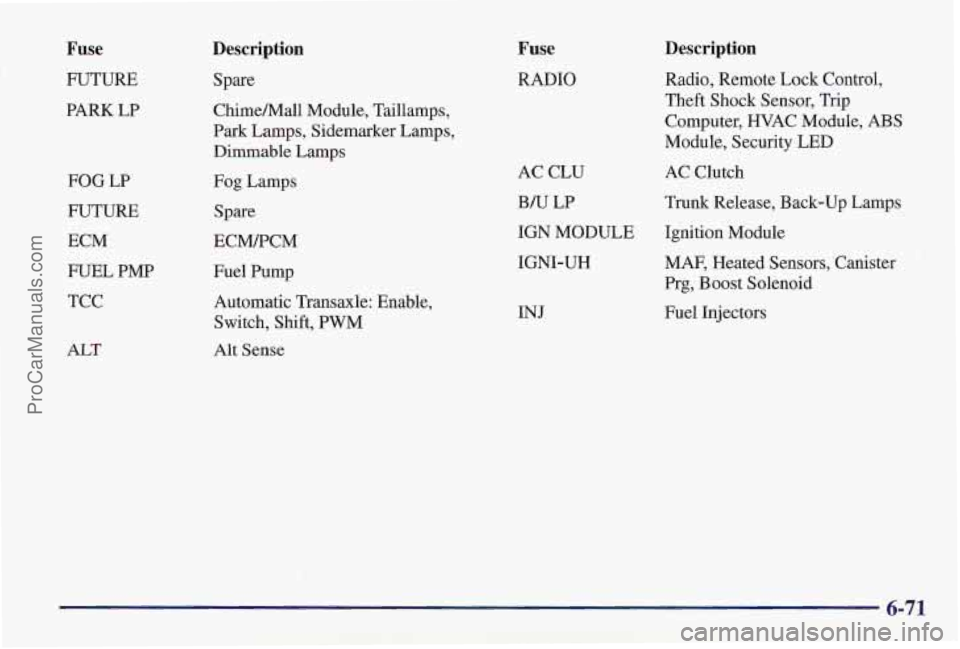
Fuse
FUTURE
PARK
LP
FOG LP
FUTURE
ECM
FUEL PMP
TCC
ALT
Description
Spare
Chimemall Module, Taillamps,
Park Lamps, Sidemarker Lamps, Dimmable
Lamps
Fog Lamps
Spare
ECM/PCM
Fuel Pump
Automatic Transaxle: Enable,
Switch, Shift,
PWM
Alt Sense
Fuse
RADIO
AC CLU
Description
Radio, Remote Lock Control,
Theft Shock Sensor, Trip
Computer, HVAC Module, ABS
Module, Security LED
AC Clutch
B/U LP
Trunk Release, Back-up Lamps
IGN MODULE
Ignition Module
IGNI-UH
INJ MAF,
Heated Sensors, Canister
Prg,
Boost Solenoid
Fuel Injectors
6-71
ProCarManuals.com
Page 342 of 419

Replacement Bulbs
Exterior Lamps Bulb Number
Back-up ............................... 3 156
Center High-Mounted Stop
................ 1141
Front Parking/Turn Signal
.............. .3357NA
Headlamps ............................. 9007
Stop/Tail/Turn Signal ..................... 3057
Front/Rear Side Marker .................... 194
Capacities and Specifications
Please refer to “Recommended Fluids and Lubricants”
in the Index for more information.
Automatic Transaxle with Overdrive .
Pan Removal and Replacement ... 7.4 quarts (7.0 L)
After Complete Overhaul ......... 10 quarts (9.5 L)
When drainingheplucing converter or auxiliary coolel;
more fluid may be needed,
Cooling System Including Reservoir
3100 (Code M) .............. 11.0 quarts (10.42 L)
3800 (Code K) .............. 10.2 quarts (9.63 L)
3800 Supercharged (Code 1) ... 10.2 quarts (9.63 L)
Refrigerunt (R- 134a),
Air Conditioning” ............. 1.9 pounds (0.85 kg)
Engine Crankcase (Oil Change with Filter Change)
3 100 (Code M) ................ 4.5 quarts (4.3 L)
3800 (Code K) ................ 4.5 quarts (4.3 L)
3800 Supercharged (Code 1) ....... 5 quarts (4.7 L)
Fuel Tank ................. 18.0 gallons (68.0 L)
*See “Air Conditioning Refrigerants ’’ later in this section.
3100 (Code M) Engine Specifications
Type .................................... V6
Displacement ............... 191 CID (3.1L L82)
Firing Order ...................... 1-2-3-4-5-6
Thermostat Temperature
........... 195°F (91°C)
Horsepower
............................. 160
3800 (Code K) Engine Specifications
Type .................................... V4
Displacement ............... 231 CID (3.8L L36)
Firing Order ...................... 1-6-5-4-3-2
Thermostat Temperature
........... 195°F (91°C)
Horsepower ................ ......... 195
6-72
ProCarManuals.com
Page 343 of 419

3800 Supercharged (Code 1)
Engine Specifications
Type .................. ............. V6
Displacement
......... . . 231 CID (3.8LL67)
Firing Order ...................... 1-6-5-4-3-2
Thermostat Temperature 195°F (91OC)
Horsepower
............ . 240
Vehicle Dimensions
Wheelbase ...........
Tread Width
Front
...
Rear ........ ,..
Overall Length ......
Overall Width .....
Overall Height ........
, . 110.5” (280.7 cm)
....... 61.7” (156.8 cm)
..... 61.1” (155.2 cm)
. 196.5” (499.1 cm)
. . 72.7” (184.5 cm)
....... 54.7” (139.0 cm)
.......
Normal Maintenance Replacement Parts
Air Cleaner Filter
Battery
All Engines ..... ... A1208C
3100 (Code M) ................. 600 CCA
3800 (Code K) ...................... 690 CCA
3800 Supercharged (Code 1) ........... 770 CCA
Engine Oil Filter
PCV Valve Radiator Cap
Spark
Plugs
All Engines ................... AC Type PF47
All Engines .... ... CV892C
All Engines
. . . . AC Type RC27
3100 (Code
M) ...
.......
..... AC Type 41-940
Gap:
0.060” (1.52 mm)
3800 (Code K) . . ..... AC Type 41-921
Gap: 0.060” (1.52
mm)
3800 Supercharged (Code 1) ..... AC Type 41-921
Gap:
0.060” (1.52 mm)
Type ..................... ........ Hook
Length ...................... 20” (50.8 cm)
Wiper Blades
Air Conditioning Refrigerants
Not all air conditioning refrigerants are the same. If
the air conditioning system in your vehicle needs
refrigerant, be sure the proper refrigerant
is used. If
you’re not sure, ask your Pontiac dealer.
ProCarManuals.com
Page 344 of 419
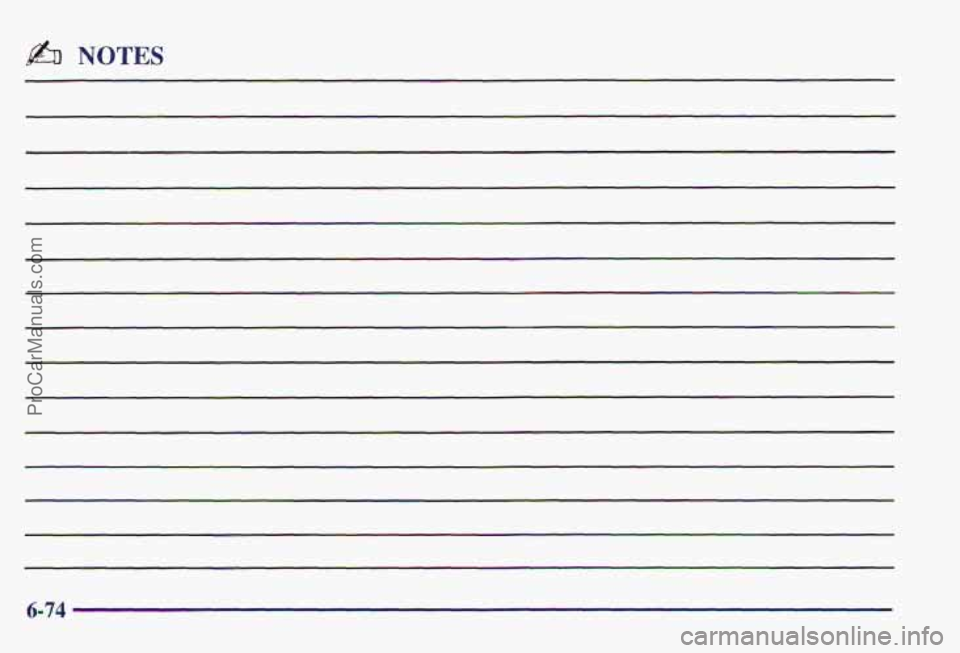
$&I NOTES
6-74
ProCarManuals.com
Page 345 of 419
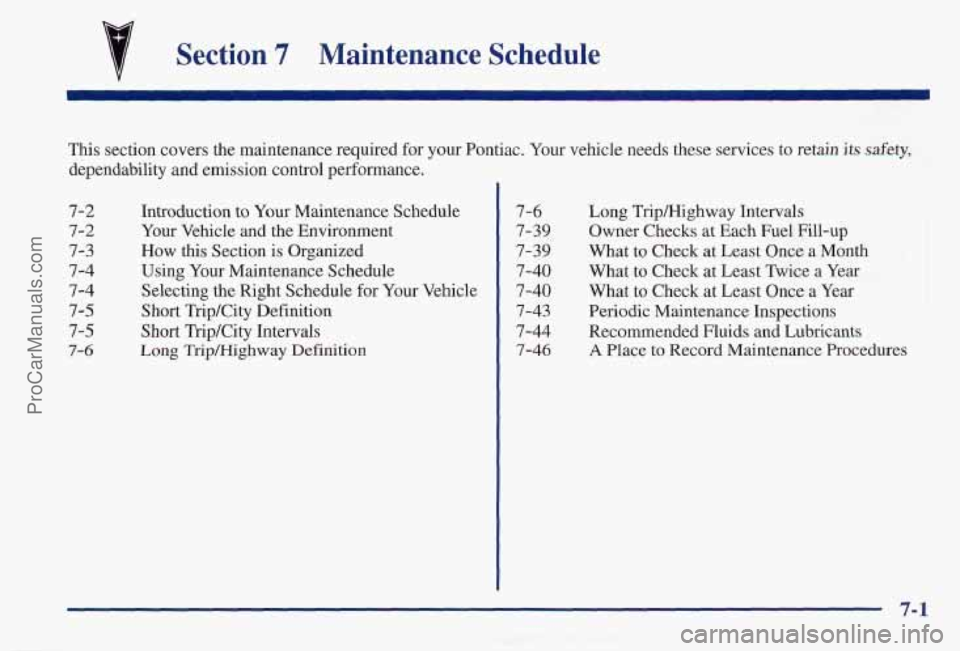
Section 7 Maintenance Schedule
This section covers the maintenance required for your Pontiac. Your vehicle needs these services to retain its &e@
dependability and emission control performance.
7-2 Introduction to Your Maintenance Schedule
7-2 Your Vehicle and the Environment
7-3
How this Section is Organized
7-4 Using Your Maintenance Schedule
7-4 Selecting the Right Schedule for Your Vehicle
7-5 Short TripKity Definition
7-5 Short Trip/City Intervals
7-6 Long Trip/Highway Definition 7-6
7-39
7-39
7-40
7-40
7-43
7-44
7-46
Long Tripmighway Intervals
Owner Checks
at Each Fuel Fill-up
What to Check at Least Once a Month
What
to Check at Least Twice a Year
What to Check at Least Once a Year
Periodic Maintenance Inspections
Recommended Fluids and Lubricants
A Place to Record Maintenance Procedures
7-1
ProCarManuals.com
Page 346 of 419
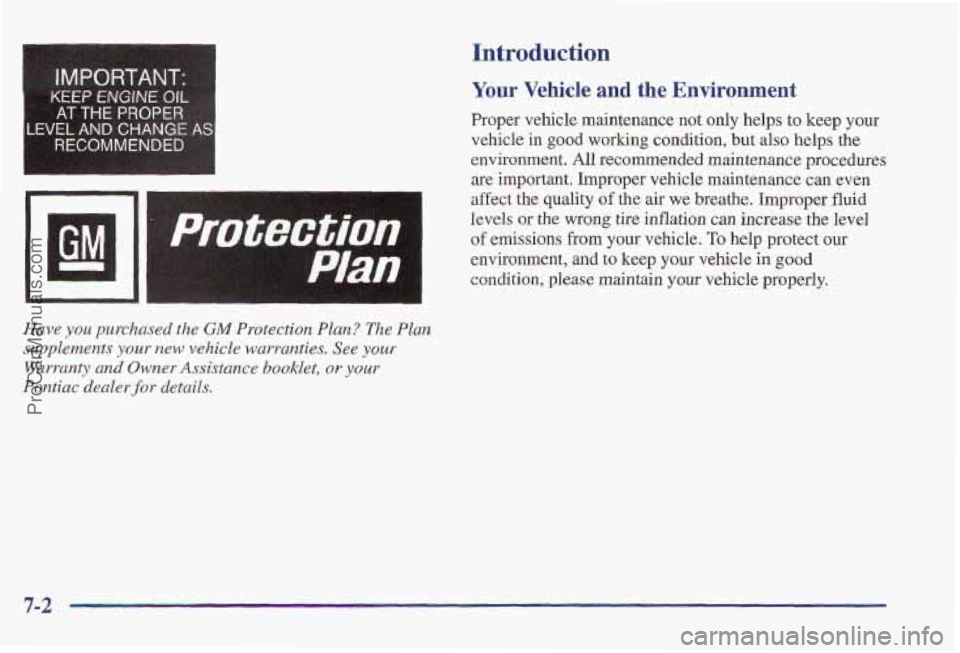
IMPORTANT-
KEEP ENGINE OIL
AT THE PROPER
LEVEL AND CHANGE AS
RECOMMENDED
I
Have you purchased the GM Protection Plan? The Plan
supplements
your rtew vehicle warranties. See your
Warranty and OwPzer Assistance booklet, or your
Pontiac dealer for details.
Introduction
Your Vehicle and the Environment
Proper vehicle maintenance not only helps to keep your
vehicle in go'od working condition, but also helps the
environment. All recommended maintenance procedures
are important. Improper vehicle maintenance can even
affect the quality
of the air we breathe. Improper fluid
levels
or the wrong tire inflation can increase the level
of emissions from your vehicle. To help protect our
environment, and to keep your vehicle
in good
condition, please maintain your vehicle properly.
7-2
ProCarManuals.com
Page 347 of 419
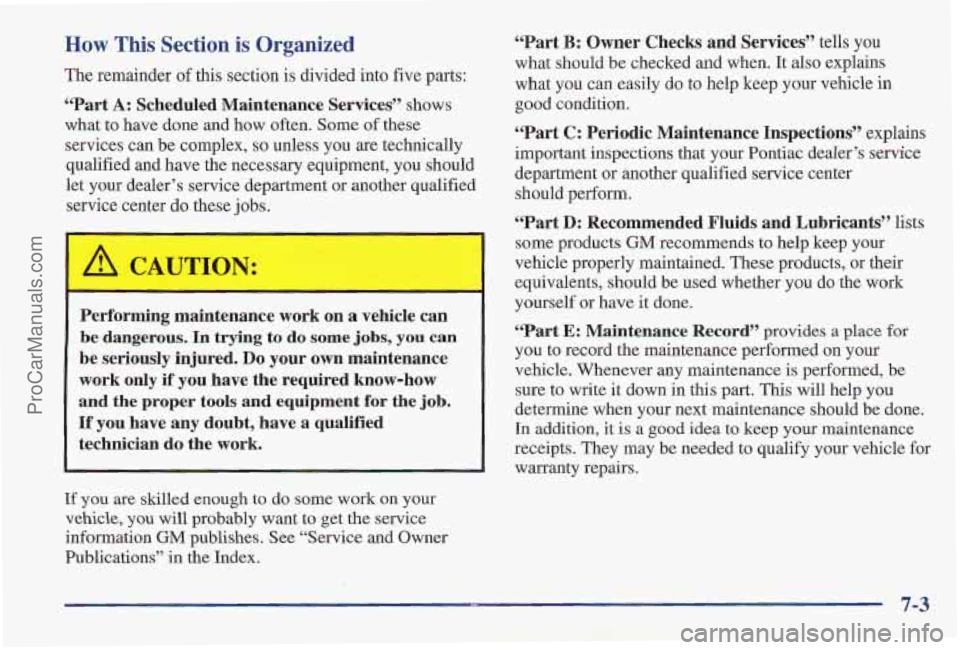
HQW This Section is Organized
The remainder of this section is divided into five parts:
“Part A: Scheduled Maintenance Services” shows
what to have done and how often. Some of these
services can be complex,
so unless you are technically
qualified and have the necessary equipment, you should
let your dealer’s service department or another qualified
service center do these
jobs.
Performing maintenance work on a vehicle can
be dangerous.
In trying to do some jobs, you can
be seriously injured. Do your own maintenance
work only if you have the required know-how
and the proper tools and equipment for the job.
If you have any doubt, have a qualified
technician do the work.
If you are skilled enough to do some work on your
vehicle, you will probably want to get the service
information
GM publishes. See “Service and Owner
Publications”
in the Index.
“Part B: Owner Checks and Services” tells you
what should be checked and when.
It also explains
what you can easily do to help keep your vehicle
in
good condition.
“Part C: Periodic Maintenance Inspections” explains
important inspections that your Pontiac
deaIer’s service
department or another qualified service center
should perform.
((Part D: Recommended Fluids and Lubricants” lists
some products
GM recommends to help keep your
vehicle properly maintained. These products, or their
equivalents, should be used whether you do the work
yourself or have it done.
“Part E: Maintenance Record” provides a place for
you to record the maintenance performed on your
vehicle. Whenever any maintenance is performed, be
sure to write it down in this part.
This will help you
determine when your next maintenance should be done.
In addition, it
is a good idea to keep your maintenance
receipts. They may be needed
to qualify your vehicle for
warranty repairs.
ProCarManuals.com
Page 348 of 419
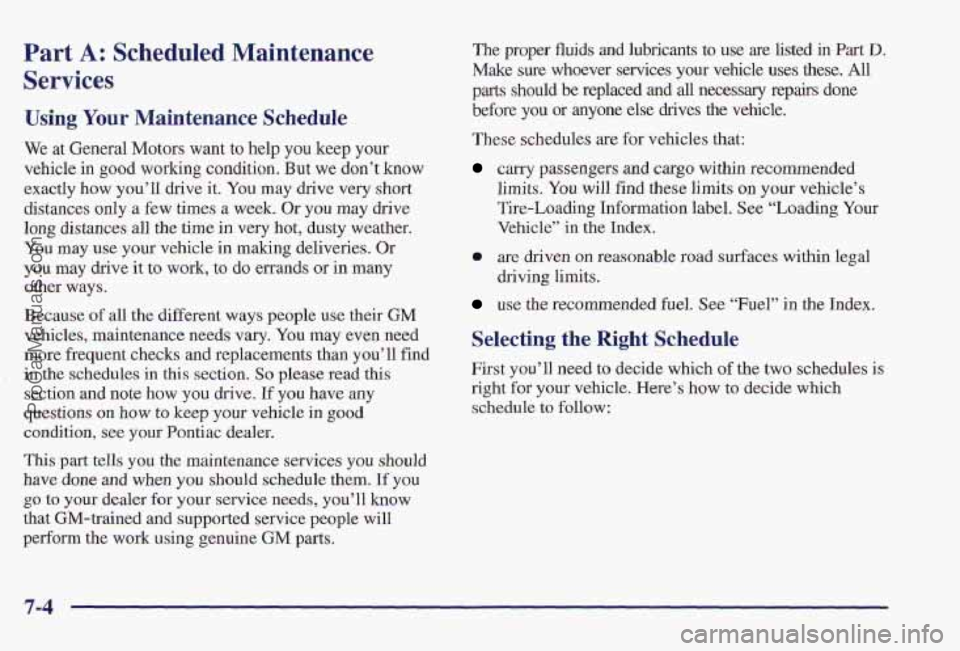
Part A: Scheduled Maintlenance
Services
Using Your Maintenance Schedule
We at General Motors want to help you keep your
vehicle in good working condition. But we don’t know
exactly how you’ll
drive it. You may drive very short
distances only
a few times a week. Or you may drive
long distances all the time in very hot, dusty weather,
You may use your vehicle in making deliveries. Or
you may drive it to work, to do errands or in many
other ways.
Because of all the different ways people
use their GM
vehicles, maintenance needs vary. You may even need
more frequent checks and replacements than you’ll find
in the schedules in this section.
So please read this
section and note how
you drive. If you have any
questions
on how to keep your vehicle in good
condition, see your Pontiac dealer.
This part tells you the maintenance services you should
have done and when
you should schedule them. If you
go to your dealer for your service needs, you’ll know
that GM-trained and supported service people will
perform the work using genuine
GM pasts. The proper fluids and lubricants
to use are listed in Part D.
Make sure whoever services your vehicle uses these. All
parts should
be replaced and all necessary repairs done
before
you or anyone else drives the vehicle.
These schedules are for vehicles that:
carry passengers and cargo within recommended
limits.
You will find these limits on your vehicle’s
Tire-Loading Information label. See “Loading Your
Vehicle” in the Index.
0 are driven on reasonable road surfaces within legal
use the recommended fuel. See “Fuel” in the Index.
driving limits.
Selecting the Right Scheldule
First you’ll need
to decide which of the two schedules is
right for your vehicle. Here’s how
to decide which
schedule
to follow:
ProCarManuals.com
Page 349 of 419
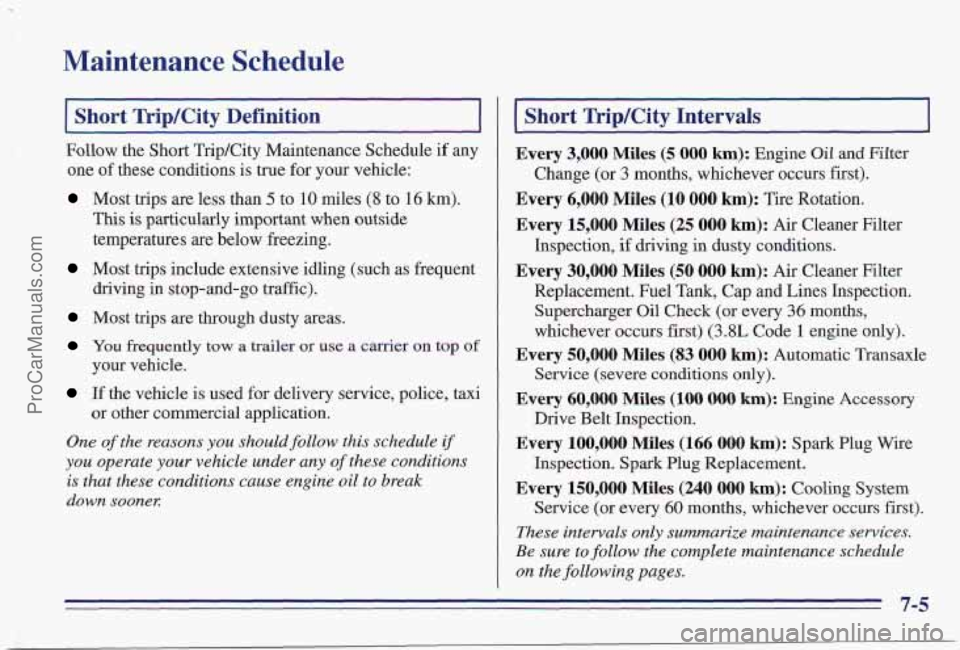
Maintenance Schedule
I Short TripKity Definition I ~____ ~~ ~~
Follow the Short TripKity Maintenance Schedule if any
one of these conditions is true for your vehicle:
Most trips are less than 5 to 10 miles (8 to 16 km).
This is particularly important when outside
temperatures are below freezing.
Most trips include extensive idling (such as frequent
driving in stop-and-go traffic).
Most trips are through dusty areas.
You frequently tow a trailer or use a carrier on top of
If the vehicle is used for delivery service, police, taxi
your
vehicle.
or other commercial application.
One of the reasons you should follow this schedule if
you operate your vehicle under any of these conditions
is that these conditions cause engine oil to break
down soonex
Short Trip/City Intervals
Every 3,000 Miles (5 000 km): Engine Oil and Filter
Change (or
3 months, whichever occurs first).
Every 6,000 Miles (10 000 km): Tire Rotation.
Every 15,000 Miles (25 000 km): Air Cleaner Filter
Inspection,
if driving in dusty conditions.
Every 30,000 Miles (50 000 km): Air Cleaner Filter
Replacement. Fuel Tank, Cap and Lines Inspection.
Supercharger Oil Check (or every 36 months,
whichever occurs first) (3.8L Code
1 engine only).
Every 50,000 Miles (83 000 km): Automatic Transaxle
Service (severe conditions
only).
Every 60,000 Miles (100 000 km): Engine Accessory
Drive Belt Inspection.
Every 100,000 Miles (166 000 km): Spark Plug Wire
Inspection. Spark Plug Replacement.
Every 150,000 Miles (240 000 km): Cooling System
Service (or every
60 months, whichever occurs first).
These intervals only summarize maintenance services.
Be sure to follow the complete maintenance schedule
on the following pages.
7-5
ProCarManuals.com
Page 350 of 419
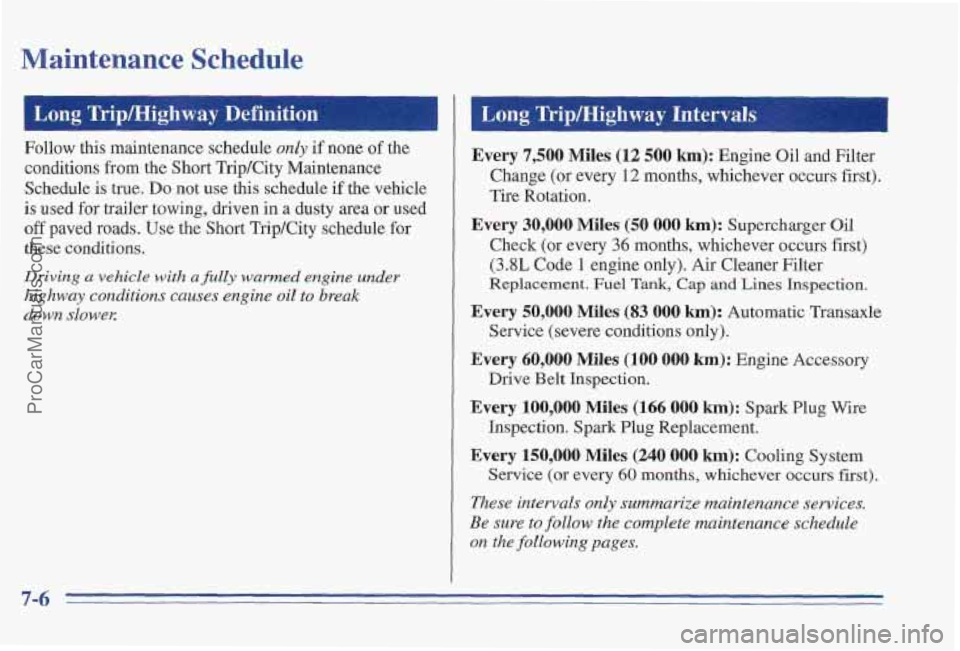
Maintenance Schedule
Follow this maintenance schedule only if none of the
conditions from the Short TripKity Maintenance
Schedule is true.
Do not use this schedule if the vehicle
is used for trailer towing, driven in a dusty area or used
off paved roads. Use the Short Trip/City schedule for
these
conditions.
Driving a vehicle with a filly warmed engine under
highway conditions causes engine oil to break
down slowel:
Every 7,500 Miles (12 500 km): Engine Oil and Filter
Change (or every
I2 months, whichever occurs first).
Tire Rotation.
Every 30,000 Miles (50 000 km): Supercharger Oil
Check (or every
36 months, whichever occurs first)
(3.8L Code 1 engine only). Air Cleaner Filter
Replacement. Fuel Tank, Cap and Lines Inspection.
Every 50,000 Miles (83 000 km): Automatic Transaxle
Service (severe conditions only).
Every 60,000 Miles (I00 000 km): Engine Accessory
Every 100,000 Miles (166 000 km): Spark Plug Wire
Drive Belt Inspection.
Inspection.
Spark Plug Replacement.
Every 150,000 Miles (240 000 km): Cooling System
These
intervals only summarize maintenance services.
Be sure to follow the complete maintenance schedule
on the fo Zlowing pages.
Service (or every 60 months, whichever occurs first).
7-6
ProCarManuals.com